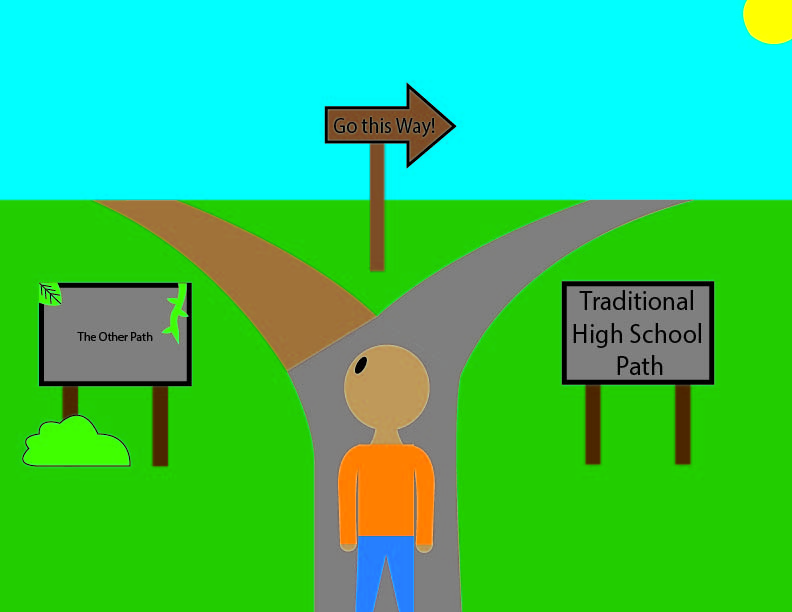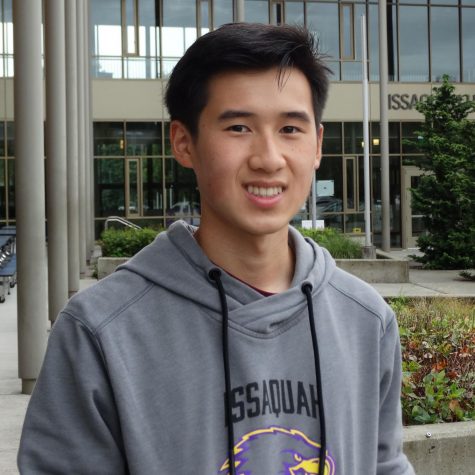The “Traditional High School Path” and the Perils of the Post-High School Experience
April 1, 2022
When you think of a “traditional” high school path, what comes to mind? Taking all the required common core classes, after-school activities, dreams of going to college and having a stable, interesting career? This path, widely considered the “traditional path,” has been long promoted to high schoolers through the media, the current job and economic climate, by other students, and through the older cohorts of society. Senior Jadin Olsen says, “There definitely is a stigma around people who don’t go the ‘traditional’ route, especially from the older generations, and it can make us feel like failures or disappointments. I personally think that it’s really brave and smart to go at your own pace, whether it be going to college as soon as possible for your passion or taking time to figure out what you want before you commit to something.” For those that choose to go their own route, it is often required to be fiercely self-motivated, due to a societal lack of external support. Freshman Connor Callaway Lampman says, “[I see myself] going off of the traditional paths. I know I can be a big star. I just need to work hard. I don’t have a fear that I won’t make my dreams come true. They will come true.”
Despite the goal we all share of making a comfortable living for ourselves as an adult, people define success in many different ways. Gen Z, in particular, has always attempted to be non-conforming to the factory-like academic system students experience. An article from ECMC Education says that “87 percent [of Gen Z] define success in five years as having a job that matches their passions” and that “67 percent said success will be defined by focusing on what they love, regardless of how much money they make.” Ideally, everyone would have a job that supports them financially and emotionally, but such jobs are becoming increasingly valuable and hard to find as of lately. The pressure to secure their future by doing exceedingly well in high school can be insurmountable for many students. Junior Varsha Bharath says, “With the amount of stress and homework you have, trying to get exercise, taking art credits that you may not be good at, and having to take a certain amount of classes, it is a lot. There’s not much freedom that we’re given, and then trying to have a social life, friends, and wanting to have fun, I don’t think it’s necessary. It is too much.” The stress of acquiring a job that aligns to an educational path you have chosen to pursue years prior is also incredibly significant. An article from Third Way says, “There’s a reason two thirds of voters say improving education should be a top priority this year. America faces an opportunity crisis. The ability to earn a good life depends heavily on a person’s skills and educational attainment, and nearly two thirds of jobs require some form of postsecondary education.”
High school students today follow a multitude different trajectories when it comes to an after high-school plan. Some students plan to go straight to a four-year college, while others plan to take a gap year, or even go into apprenticeships or the military. Sophomore Ignacio Garcia says, “I’ll do higher education or a trade school, possibly military [after high school].” Those who have the resources also find it helpful to take a year-long break after high school and before going into college. An article from Own Your Own Future says, “If you can afford to travel, use your free time to see exotic corners of the world, explore other cultures, and meet interesting people. ‘Backpacking across Europe’ may be a cliche in popular culture, but there are plenty of cultural exchange opportunities to be found all over the world.” It is also possible that a unique after-high school path can align with your interests or passions. An article from Teen Vogue says, “[Graduation] can be the opportune time in your life to see the world you have spent so much time learning about in textbooks and put those foreign languages to use. Take it from Bailey Theado, who deferred her enrollment to university for a well-organized trip of travel and volunteer work. Bailey’s adventure took her across Nepal, India, Indonesia, Malaysia, Laos and Thailand, and then to Denmark and France. This included a photojournalism internship, a project on the Akha hill tribe, and volunteering in Tibet.”
It can easily be concluded that America’s high school students of today face an enormous challenge. The road ahead is long, winding, and can often seem solitary. However, everyone is going through the struggle and discomfort that comes with having to determine your adult life with the choices you made as a child. If you follow your individual passions, find motivation in the darkest times, and learn to plan for your life ahead as early and effectively as possible, you can find true after-high school success.







